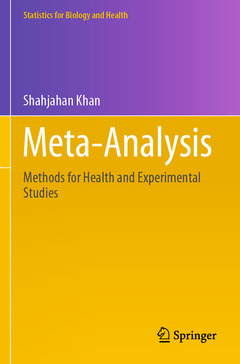Description
Meta-Analysis, 1st ed. 2020
Methods for Health and Experimental Studies
Statistics for Biology and Health Series
Author: Khan Shahjahan
Language: English
Subject for Meta-Analysis:
Keywords
Meta-Analysis; MetaXL; Statistical Meta-Analysis; Medical Meta-Analysis; Effect Size Measures; Systematic Review; Evidence-Based Decision-Making; Confidence Interval; Pooling of Effects; P-value; Publication Bias; Heterogeneous Effect Sizes; Randomized Control Trials; Fixed Effect Model; Random Effects Model; Inverse Variance Weighting; Inverse Variance Heterogeneity Model; Quality Effect Model
52,74 €
Disponible chez l'éditeur (délai d'approvisionnement : 15 jours).
Add to cartPublication date: 10-2021
293 p. · 15.5x23.5 cm · Broché
73,84 €
Disponible chez l'éditeur (délai d'approvisionnement : 15 jours).
Add to cartPublication date: 10-2020
293 p. · 15.5x23.5 cm · Relié
Résumé
/li>Sommaire
/li>Biographie
/li>Commentaire
/li>
This book focuses on performing hands-on meta-analysis using MetaXL, a free add-on to MS Excel. The illustrative examples are taken mainly from medical and health sciences studies, but the generic methods can be used to perform meta-analysis on data from any other discipline. The book adopts a step-by-step approach to perform meta-analyses and interpret the results. Stata codes for meta-analyses are also provided.
All popularly used meta-analytic methods and models ? such as the fixed effect model, random effects model, inverse variance heterogeneity model, and quality effect model ? are used to find the confidence interval for the effect size measure of independent primary studies and the pooled study. In addition to the commonly used meta-analytic methods for various effect size measures, the book includes special topics such as meta-regression, dose-response meta-analysis, and publication bias.
The main attraction for readers is the book?s simplicity and straightforwardness in conducting actual meta-analysis using MetaXL. Researchers would easily find everything on meta-analysis of any particular effect size in one specific chapter once they could determine the underlying effect measure. Readers will be able to see the results under different models and also will be able to select the correct model to obtain accurate results.
Chapter 1. Introduction to meta-analysis.- Chapter 2. Ratio measures.- Chapter 3. One proportion.- Chapter 4. Risk difference (Two proportions).- Chapter 5. Weighted mean difference.- Chapter 6. Standardized mean difference.- Chapter 7. Correlation coefficient.- Chapter 8. Meta-regression.- Chapter 9. Network meta-analysis.- Chapter 10. Publication bias.
Ces ouvrages sont susceptibles de vous intéresser

Meta-Analysis with R 58,01 €



